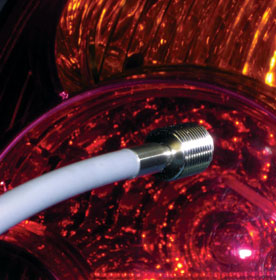High-speed, high-precision colour mark detection
March 2013
Sensors & Transducers

ASSTech Electronics has introduced the Spectro-3-FIO colour mark detector that can detect colour like a human at a sample frequency up to 40 kHz. The use of reflected-light optical fibres allows this sensor to be employed in Ex areas.
A super-bright white light LED is directed onto the colour mark to be detected. Various optical fibres and attachment optics units are available to allow a high precision detection. For example, at a distance of approximately 10 mm from the object, the light spot can have a diameter as small as 0,5 mm.
An integrated three-fold receiver for the red, green and blue content of the light that is reflected from the object, or the light that is emitted by a self-luminous object, is used as a receiver. A special feature is that the gain of the receiver can be set up in eight steps making it possible to adjust the sensor to almost any surface. Using the Teach button on the Spectro-3-FIO housing, the sensor can be taught up to 31 colours.
All parameters and measurement values can be exchanged between a PC and the colour sensor through the serial RS232 interface. Once set, the sensor continues to operate with the current parameters in stand-alone mode without the PC.
For more information contact Anastas Schnippenkotter, ASSTech Process Electronics & Instrumentation, +27 (0)11 708 9200, [email protected], www.asstech.co.za
Further reading:
Adjustable proximity sensor with five metre range
Sensors & Transducers
The Telco line of photo-electric eyes have the accuracy and reliability you need.
Read more...
Food safety – a matter of weight
Sensors & Transducers
Weighing systems play a key role in ensuring product quality in food production, complying with legal requirements and avoiding product recalls. The Minebea Intec MiNexx portfolio has been specially developed to meet these requirements.
Read more...
Telco sensors in the paper and pulp industry
Sensors & Transducers
The paper and pulp industry poses a major problem for most photoelectric sensors. Telco Sensors has overcome this with its powerful and high-performance photoelectric sensors, ensuring penetration of thick and harsh pollution while guaranteeing reliable detection.
Read more...
Leaders in sensor technology
Sensors & Transducers
A new addition to the Telco Sensors range is the adjustable Proximity sensor, with a range up to 5 metres.
Read more...
Cutting-edge sensor technology
Endress+Hauser South Africa
Sensors & Transducers
The advantage of Endress+Hauser’s Memosens technology is that digitised measured values and sensor information are transmitted via a non-contact connection from the sensor to the cable, and as a digital signal to the transmitter.
Read more...
Miniature inductive sensors
ifm - South Africa
Sensors & Transducers
The inductive IY/IZ type sensors from ifm are used in various industrial areas where space is limited.
Read more...
The expanding role of 3D cameras in industrial quality control
TANDM Technologies
Sensors & Transducers
Across factory floors, warehouses, mines and research centres worldwide, computer vision paired with 3D camera technology is revolutionising quality control.
Read more...
PDS implementation on mines
Sensors & Transducers
Level 9 vehicle intervention for collision avoidance has been mandatory on South African mines since 2022, yet the effective roll-out of proximity detection systems remains slower than expected. This is not due to the technical limitations of integration but to operational readiness on site.
Read more...
Monitoring analogue process values
ifm - South Africa
Sensors & Transducers
Everywhere in industry, electronic sensors are used to detect process values such as temperature, pressure or flow. Process value monitoring often takes place directly in the sensor.
Read more...
Protecting buildings’ embodied carbon with retrofitted systems
Schneider Electric South Africa
Sensors & Transducers
The World Economic Forum has said that around 80% of the buildings in existence will still be around in 2050; it is therefore essential that in order to combat climate change we retrofit them for energy efficiency.
Read more...


